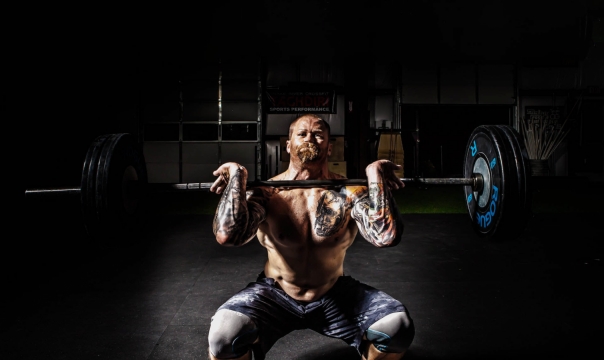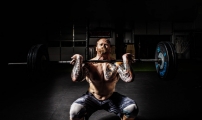Top Things To Consider When Purchasing Powerlifting Gear

You may be considering buying some lovely new powerlifting gear. Perhaps those knee wraps would increase your squat by 10%. Or, maybe those wrist straps will finally stop you from dropping your third rep of 495 on the deadlift.

In any case, you should do some thorough research before buying a piece of powerlifting gear. This can prevent you from having to spend money a second time later when you realize the thing you bought isn't allowed at your meet.
What is Powerlifting Gear?
Powerlifting gear is the collection of items used in powerlifting to improve performance, longevity, and comfortability during lifts and competitions. These items include belts, shoes, knee sleeves & knee wraps, wrist wraps, wrist straps, chalk, and singlets. These items are commonly referred to as "the stuff in your gym bag," but for the purposes of this article, only the powerlifting-specific gear that is worn will be discussed. Things like headphones, water bottles, and pieces of gym equipment will not be touched on.
How to Choose the Right Powerlifting Gear | Powerlifting Gear Guide
Belts
There are two main types of belts, lever belts, and prong belts. Prong belts have metal prongs that fit into holes along the belt like traditional belts for pants. Some prong belts have a single prong, and some have two. The other type of belt, lever belts, are set to a particular size ahead of time. Then, when a lifter is ready to use the belt, they simply position it where they want it vertically along their core and shove the lever to the side, synching the belt tight on their body.
While lever belts are usually a bit more expensive than prong belts, they're also much more convenient. They are not great for sharing, but if you are looking for a dedicated belt for yourself, a lever belt will probably be a better choice. Some lever belts, such as the innovative SBD Lever Belt, have more extensive functionality. The SBD Lever Belt features a patented gliding lever that gives it the versatility of a prong belt with the convenience of a lever belt. Similar belts like the Pioneer Adjustable Lever Belt offer the adjustability of an SBD Lever Belt or a prong belt, but of the adjustable lever belts, only the SBD is approved for use in meets following IPF regulations.
Both prong and lever belts have options that are IPF-approved, but that feature will usually cost some money. Belts meeting specifications of 10 centimeters or less in width and 13 millimeters or less in thickness will be allowed for use in local and some regional-level powerlifting meets. However, for anybody with national or global aspirations in powerlifting, an IPF-approved brand will be required.
Shoes
For powerlifting, you can go very far with any shoe that has flat, thin, and rigid soles. However, for squats, many people prefer a platform shoe or a squat shoe. These shoes also have rigid soles, but they have a wedged shape that lifts the heel higher off the ground compared to the toes. This dramatically reduces the ankle mobility required to reach depth in your squats. If you're going for some basic flat-soled shoes, Vans, Converse, or a barefoot shoe will all be great choices. It's important to note that squat shoes or weightlifting shoes with elevated soles, while great for squats, are sub-optimal for deadlifts. They take the tension out of the posterior chain and will not help you to recruit the essential muscle fibers for the lift.
Knee Sleeves or Knee Wraps
Many novice or intermediate powerlifters will want to use knee sleeves to keep the knee joints warm and compressed. This can reduce pain and discomfort, provide support and stability, and even avoid knee injury. Some people say that knee sleeves will directly add weight to your squat, but there's very little evidence to support this. A piece of equipment that will add weight to your squat is knee wraps. They're like knee sleeves but provide significantly more compression, support, and rigidity. They're only allowed in equipped powerlifting formats, so for raw powerlifting, 7-millimeter thick knee sleeves are the best-allowed knee support gear.

Wrist Wraps and Wrist Straps
Wrist wraps and wrist straps are two commonly confused pieces of lifting equipment that have two entirely separate sets of functions. Wrist wraps, much like knee wraps, support the wrists, provide compression, and stabilize the joint throughout the movement. Unlike knee wraps, they are usually meant to restrict movement in the wrist to avoid your hands falling backward while pressing. They can also be used while squatting and deadlifting, but it's less common. Wrist wraps protect one of the thinnest and most vulnerable joints on the body through heavy compound pressing lifts, namely the bench press. They can also prevent the bar from falling backward out of your hands during low bar squats or provide slight assistance to your grip during deadlifts by compressing the tendons in the wrist.
Wrist straps, on the other hand, are meant to help you to grip the bar almost exclusively during the deadlift. Instead of wrapping around the wrists, the wrist goes through a loop made by the strap, and the strap is wrapped around the bar. This makes it practically impossible to drop the bar due to grip failure, as you just have to hold the strap against the bar. The multiple wraps around the bar and the non-slip material on one side of the strap make the frictional connection very strong. Overuse of wrist straps can cause a weak grip strength, so it's recommended only to use them on long sets. You should still be able to complete a one-rep max without the use of wrist straps.
Most equipped format powerlifters will want a pair of wrist wraps for competition and training use. Wrist straps are often used by newbies but can also be used competently during deadlifts. It's crucial to avoid using them during all of your heavy pulls, but when doing several reps of a reasonably heavy weight, it can help you to strengthen your posterior chain by removing the potential bottleneck of grip from the equation. During one-rep max attempts and many of the lighter and moderate sets, it's recommended to use your grip strength, as usual, to strengthen it and ensure it is strong enough for competition. In competitions, you will not be able to use straps, so be prepared to use chalk!
A Note About Chalk
While it doesn't make much of a difference what chalk you actually get, it's highly recommended not to break it up. Not only is it wasteful, but it's also messy and disrespectful to the owners and workers of your gym. By all means, if your gym offers loose chalk in bowls lying around, use it! However, if you're bringing your own chalk, it's best to keep it in block form and rub it onto the desired locations on your hands to use it. This will preserve the chalk for longer and make less of a mess for you or someone else to clean up later.
Another quick note about chalk is that there is another white, powdery substance commonly used in powerlifting. You'll see this placed on the center of the barbell during deadlifts or even on the thighs of a deadlifter. This other substance is not chalk. It is baby powder, which has quite the opposite effect. Chalk is meant to increase the frictional forces between surfaces it sits between, while the baby powder reduces those frictional forces. This is used to help the bar slide up the legs and singlet more quickly than without it. Do not use chalk in place of baby powder or baby powder in place of chalk. It will put you in a particularly challenging position as either the bar tugs on your legs and clothes on the way up or slips out of your hands easily.
Singlets and Lifting Suits
Finally, the singlet is the foundation for all other pieces of gear. The lifting suit you choose will depend primarily on one factor. Do you plan to lift raw or equipped? Raw powerlifting only permits standard singlets, which are pretty stretchy and don't store much elastic energy. Equipped formats will allow single-ply or multi-ply singlets, which absorb and release much more significant amounts of energy during the lift. The other main factor is whether or not you plan to compete at a national level or higher. If so, or if you know a competition you'll enter is IPF regulated, you'll need a singlet that is approved for IPF usage. There are a handful of brands allowed for use in the IPF, so it's best to look up the most up-to-date IPF brand approval list for singlets.
Why it's Important to Understand Equipment for Powerlifting
Put simply, powerlifting is a dangerous and challenging sport. If you are not well equipped for the challenges ahead, your performance will suffer greatly, but your risk of injury will be higher than necessary. In addition to these difficulties, there are a lot of restrictions on equipment for powerlifting and a lot of equipment that is not allowed in raw and IPF formats. Raw formats don't allow thicker, more energy-absorbent gear like knee wraps and multi-ply singlets, while IPF-regulated meets only allow a particular list of brands to be used. It's important to distinguish which format and level you want to compete in to determine which pieces of gear will be best for your goals and ambitions. The only way to properly do this is to understand what gear is allowed for what types of competitions.





